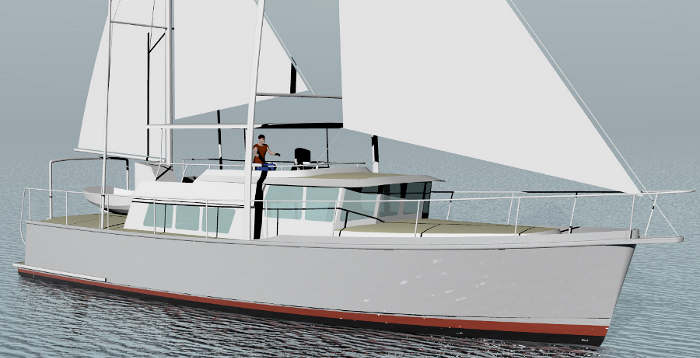PassagemakerLite Prototypes: A Brief History of Lightweight Motoryachts
 Passagemaker Lite design series is Tad Roberts' modern, lightweight, fuel-efficient re-statement of the fast, seaworthy, long-range power cruiser. There are now two series, the orginal traditional one and a modern one, in lengths from 39' to 98'. Read more:
Passagemaker Lite design series is Tad Roberts' modern, lightweight, fuel-efficient re-statement of the fast, seaworthy, long-range power cruiser. There are now two series, the orginal traditional one and a modern one, in lengths from 39' to 98'. Read more:
-
1937 to 1969: An Overview of Four Early (Lightweight) Offshore Cruisers
Transoceanic cruising in powerboats began in 1937 when French yachtsman Martin Marie crossed the Atlantic alone in Arielle. There had been several transatlantic stunt voyages prior to that, but this was the first real ocean cruise in a powerboat.
Arielle - Martin Marie
Transoceanic cruising in powerboats began in 1937 when French yachtsman Martin Marie crossed the Atlantic alone in Arielle. There had been several transatlantic stunt voyages prior to that, but this was the first real ocean cruise in a powerboat. Marie was a marine painter, and he wished to spend time with his subject. Arielle was 42’6” (13m) LOA and of moderate displacement and proportion; certainly not a massive heavyweight. He drew up extensive specifications for his vessel, including the addition of a wheelhouse—a first for ocean-cruising powerboats. Fitted with a 75-hp Baudoin diesel and 1,500 gallons (5,678.1 l) of fuel, the boat cruised from New York to Le Havre, France in 19 days. This calculates out to a respectable average speed of 6.7 knots for the distance of 3,063 miles (4,929.4 km). Arielle’s cruise passed without incident: the engine ran smoothly and the crew met no heavy weather. Therefore, the journey generated no dramatic press. Ocean-cruising under power was obviously not heroic and possibly considered a bit boring.
Marco Polo - Francis Herreshoff
After the Second World War, Francis Herreshoff published a design for a long-distance offshore cruiser he called Marco Polo. Long, lean, and light, Marco Polo was designed for efficiency under power, but was also equipped with sails for steadying, additional drive, and get-home power. A three-masted rig provided adequate sail area down low with lots of combinations available, depending on wind strength and velocity. No sail was too large for the single watch-keeper Herreshoff envisioned. Marco Polo was intended to be driven around the clock at 10 knots, a tremendous speed at a time when sailing ocean cruisers averaged 100 miles (160.9 km) per day. The boat is 55’ x 10’ (16.8m x 3m), with a designed displacement of 42,500 lbs (19,277.7 kg). On a 49’ (15m) waterline this is a displacement/length ratio of 161. Marco Polo has an outside ballast keel of 14,600 lbs (6,622.5 kg)—34% of its displacement—reflecting the fact that the vessel carries 812 sq ft (75.4 sq m) of sail. Herreshoff claimed it would sail well in moderate and heavy weather, as well as go farther and faster than many pure powerboats.
Herreshoff’s Marco Polo influenced the thinking of a number of designers, including Robert Beebe, who wrote the book Voyaging Under Power. After a 1957 voyage from New York to the Bahamas in a Marco Polo, Beebe wrote in The Rudder magazine, “The hull is terrific. The action of the boat in a seaway was a joy to behold.” There was later talk that the boat’s motion and speed were too lively, and that it was uncomfortable. But, it seems this may have been a function of short steep seas. Also, that particular Marco Polo was not built as designed. Finally, the motorsailing potential of Beebe’s Marco Polo was never realized, because he and his crew sailed the entire distance. The designer’s performance claim was substantiated, however, when the boat averaged six knots over 1,000 miles (1,609.3 km), mostly in heavy seas under reduced sail.
Jim Hawkins - Avard Fuller
Avard Fuller is an amateur designer who saw potential in long lean hulls, as well. While working with builder Bob Derecktor, Fuller developed a series of light-displacement ocean cruisers. One example of Fuller’s work is Jim Hawkins, a 61’ x 13’ (18.6m x 4m) yacht launched in 1969 that displaced 47,500 lbs (21,545.6 kg), fully loaded. With a 58’4" (17.8m) LWL, the displacement/length ratio is 107. Two Volvo Penta MD29 engines generate 64-hp each and push the boat at a maximum of 9.5 knots in smooth water. At 7.5 knots, and a speed/length ratio of 0.98, the engines are running at 1,850 rpm and burning 2 gal/hr (7.6 l/hr). When new, Jim Hawkins ran the 1,170 miles (1,882.9 km) from Morehead City, North Carolina to St. Thomas, Virgin Islands in 140 hours while burning 561 gallons (2,123.6 l) of fuel. Average speed was 8.35 knots and fuel consumption was just over 4 gal/hr (15.1 l/hr).
Jim Hawkins’ design included several innovative features, the first being Bob Derecktor’s spray rail, which is a wide horizontal shelf well above the DWL. The idea was to achieve fine waterlines down low for minimum resistance, and to add buoyancy in the topsides. At higher speeds the spray rail is also necessary to stop the wake from running up the topsides. Jim Hawkins’ “shelf” is 6” (152.4mm) wide at the stem, tapering to nothing at station eight. Fuller also included two methods of roll stabilization aboard the boat. The first was a very short sailing rig, which was understandable since Fuller had been a sailor for 30 years. But, he found the sails were only useful when he had a stiff breeze on the beam—a rare occurrence. As speed under power increased, the apparent wind moved forward and the sails luffed uselessly.
His second method of stabilization was more successful: a daggerboard that extended Jim Hawkins’ draft by 5’6” (1.7m). Fuller stated in an article in Yachting magazine (June 1972) that the daggerboard damped out most of the rolling in all ordinary conditions and made the boat quite comfortable. Of course, there are structural concerns, but it would be interesting to compare drag and roll-damping between this type of daggerboard and the bilge keels or fins that have become common today.
Little Goose - William Garden
In 1955 William Garden created Little Goose, which was 63’ x 15’ (18.3m x 4.6m), running at 9 knots with 120 hp. My Passagemaker Lite arrangement (see main text) is descended from that of Little Goose.
-
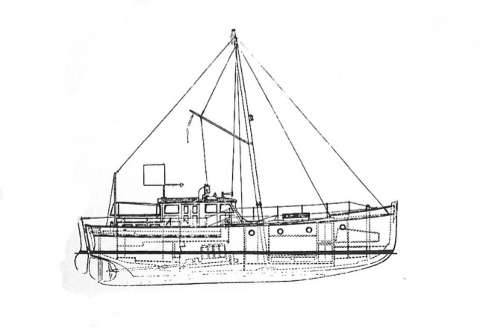 1937. Martin Marie's Arielle
1937. Martin Marie's Arielle
-
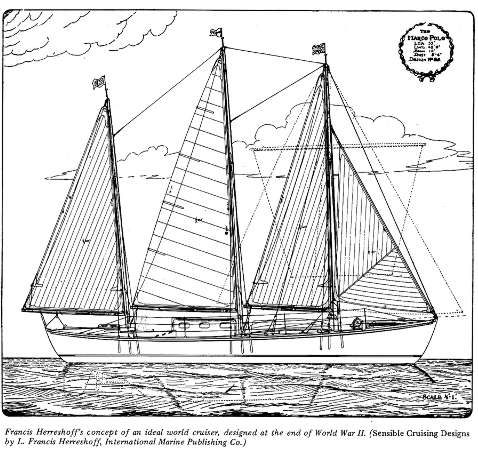 194-. Francis Herreshoff's Marco Polo
194-. Francis Herreshoff's Marco Polo
-
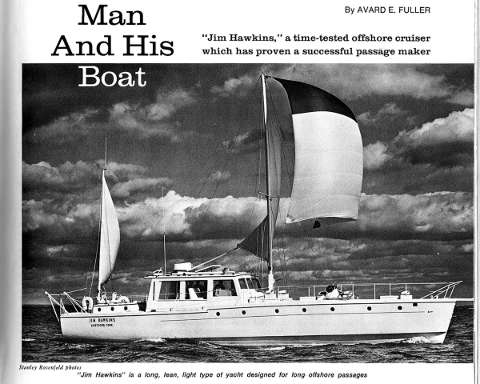 1969. Avard Fuller's Jim Hawkins
1969. Avard Fuller's Jim Hawkins
-
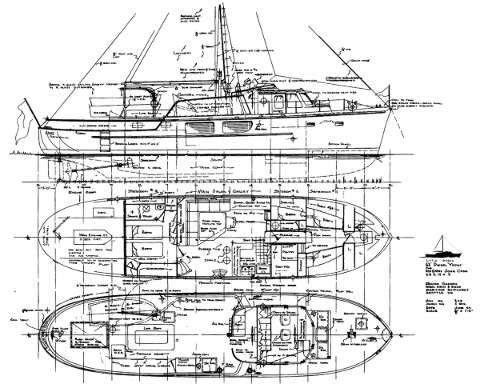 1955. William Garden's Little Goose
1955. William Garden's Little Goose
